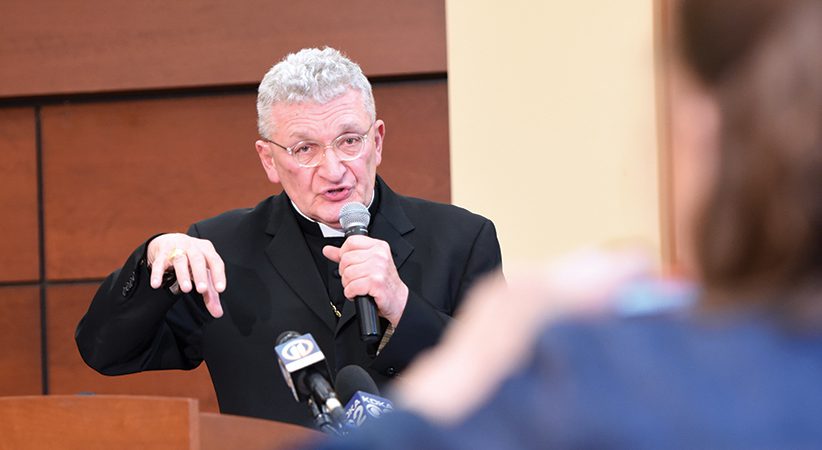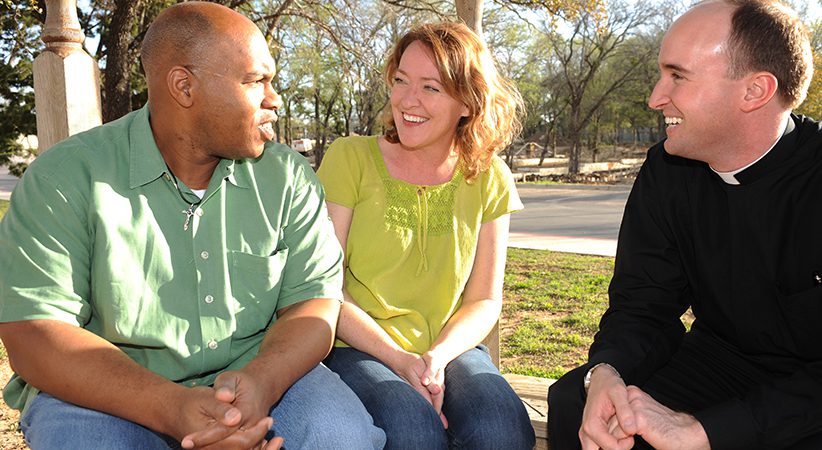Strengthening the Catholic Identity and Purpose of Parish Schools
How Catholic schools serve the dual purpose of education and evangelization
Dr. Max T. Engel, Father Tom Simonds Comments Off on Strengthening the Catholic Identity and Purpose of Parish Schools
Operating a Catholic school is a “prophetic choice” according to the Vatican Congregation for Catholic Education. In its important document on Catholic schools, “The Catholic School on the Threshold of the Third Millennium,” the congregation calls the decision to operate a school “prophetic” because of the importance that the Catholic school has for the Church and the world.
The Catholic school is one of the fundamental ways that the Church engages in the ministry of evangelization. At the same time, Catholic schools meet the needs of society for well-educated men and women who can participate in a democracy and contribute to their communities. So they have a dual purpose, to educate and to evangelize, and this dual purpose is accomplished through one integrated curriculum. In this article, we describe a process pastors and their collaborators can use to ensure that their schools are both educating and evangelizing.
Naming Identity and Purpose
In terms of identity, the Catholic school is both an apostolic ministry of the Catholic Church and an institution of education. In terms of purpose, the Catholic school seeks to prepare children and youths for responsibilities as adults through a synthesis of knowledge, culture and the Gospel of Jesus Christ. Several important documents define and describe the identity and purpose of Catholic schools. We have based our discussion in this article on two of these documents that we think provide clear and actionable information.
The first document we want to highlight is the “National Standards and Benchmarks for Effective Catholic Elementary and Secondary Schools.” This document was developed as a result of a national collaborative effort overseen by the Center for Catholic School Effectiveness at Loyola University Chicago and the Roche Center for Catholic Education at Boston College. The National Standards document defines best practices for Catholic schools and provides detailed benchmarks that school personnel can use to apply best practice standards to their own institutions.

The second document we highlight in this article is “The Catholic School on the Threshold of the Third Millennium,” mentioned above In this document, the Vatican Congregation for Catholic Education clearly describes and defines the identity and purpose of a Catholic school. The congregation notes that the schools are a key means for the Church to address the current “crisis of values” in our world by engaging in the evangelization of students and families.
Unfortunately, this crisis of values plagues our schools as well as our society. The common school, or public school as we now call it, began in the United States in the 1800s with the idea that a common baseline Christianity could be part of the common school. Over the years, as the religious beliefs of U.S. citizens have become increasingly diverse, this initial compromise has broken down.
Presently, not only Christianity but anything faintly related to Christianity, or even religion, have been meticulously removed from the common school. For example, all mention of Easter and Christmas have become verboten, prayers before activities are forbidden and students may exempt themselves from saying the pledge of allegiance because of the line, “one nation under God.” The founders of the common school knew that children needed religion as a key source of values and formation, but religion has now been completely erased from these schools.
While any form of religion has been removed from the common school, many parents want religion and values formation to be a part of their children’s educational experience. And so the Catholic school is uniquely positioned to provide a type of education that the common school is no longer able to provide. Rather than being a trait to downplay, religious formation provided by Catholic schools is something to celebrate and trumpet from the rooftops because it is the way they can differentiate themselves from every other school.
In terms of the life of the Catholic parish, Catholic schools provide opportunities for sacramental preparation of children as well as opportunities for further evangelization and catechesis with parents. Building the enrollment of your Catholic school can directly benefit the life of your parish by attracting young families and by providing opportunities for parishioners to be involved in passing on their faith and values to the next generation. So we want to introduce you to a process that will help you enhance the Catholic identity of your school so it can fully engage in its core purpose of education and evangelization.
If your parish does not have a school, the process we describe could be used to discern which Catholic school in your city, town or region you might like to partner with to provide a Catholic school option for the families in your parish. The idea of multiple parishes sponsoring or collaborating to operate one school is becoming more popular as educators and pastors explore the most cost-effective means to provide an authentic Catholic education.
Claiming Identity and Purpose
An important initial step in claiming your school’s Catholic identity is to engage in a mission-effectiveness review process, which begins by using a set of external standards to assess your school’s operations. We suggest two options for external benchmarking standards. The National Standards and Benchmarks Project, previously mentioned, is one good option. For more information about the group and publications on this topic, locate “The Catholic School Standards Project” on the worldwide web and review the sidebar in this article.
“The Catholic School on the Threshold of the Third Millennium” by the Congregation for Catholic Education is the second option we propose using to assess the mission effectiveness of your Catholic school. Here, the Vatican congregation describes five defining characteristics of a Catholic school.
………………………………………………………………………………………………………………………………………………………………..
 Catholic Schools Week, Jan. 31 through Feb. 6, is a week of Masses, assemblies and other activities for students, families, parishioners and community members to celebrate and recognize accomplishments. The theme this year is “Catholic Schools: Faith. Excellence. Service.”
Catholic Schools Week, Jan. 31 through Feb. 6, is a week of Masses, assemblies and other activities for students, families, parishioners and community members to celebrate and recognize accomplishments. The theme this year is “Catholic Schools: Faith. Excellence. Service.”
…………………………………………………………………………………………………………………………………………………………………
First, a school is Catholic if the hiring and professional development processes at the school focus on recruiting and forming teachers, leaders and support staff who are skilled at teaching the Catholic Faith by their words, deeds and the model of their life. Second, a school is Catholic if the educational process facilitated by these highly qualified educators seamlessly integrates religion with every aspect of the curriculum and school program.
Partnerships with parents are the third defining characteristic of an authentically Catholic school. Through partnerships with parents, educators engage in the formation of youths for their future responsibilities in the Church and the world. The active and effective participation of clergy and religious in the school is the fourth defining characteristic.

The fifth is that the school has the financial means to accept all families who want to enroll their children at the school. And while this particular defining characteristic is challenging in our current context, recall that the Vatican Congregation for Catholic Education called the decision to operate an authentically Catholic school “prophetic.” At the same time, the call to pastors is not to attempt to finance a school on their own, but rather to develop partnerships with parents, clergy, religious, local leaders and political leaders.
Advocacy for parental choice in education is one promising avenue to explore. Talk with staff at your state Catholic conference or (arch)diocesan office for more information.
To determine how documents, programs and curriculum at your school are already aligned with the five characteristics of a Catholic school described by the Vatican Congregation for Catholic Education ask yourself this question: To what extent does our school mission statement already include the five characteristics of a Catholic school?
The five characteristics can also be used to review your vision statement for your graduates after graduation. For example, if you sat down with a group of collaborators to review your existing vision statement for your graduates based on the purpose of a Catholic school, you would expect to see references to the following points.
Our graduates will:
• Actively practice their Catholic Faith.
• Integrate religion with all aspects of their life.
• Prioritize family life.
• Actively participate in neighborhoods and communities.
• Discern their vocations.
• Support the school community.
Building Identity and Purpose
To enhance and build upon the ways you already actualize the identity and purpose of your school, consider whether gaps and lacunae exist in important areas in your documents and programs by asking two questions.
When we consider the school in light of the five characteristics of an authentically Catholic school, where do gaps exist between who we say we are, what we do and the five characteristics?
When we consider the school in light of the five characteristics of an authentically Catholic school, have we failed to address any of the characteristics in our statements of identity and purpose or in policies and practices?
Mission Statement and Motto
One key document to review is your school’s mission statement. Imagine that you and a group of stakeholders engage in a review of your school’s mission statement. You and your group discover that the mission statement does not address all of the five characteristics of an authentically Catholic school. Then you work with the group members and rewrite your school’s mission statement so that it includes all of the five characteristics.
Your rewritten mission statement might look something like this: “We are a Catholic community of parents, children, educators, priests and religious who have made the prophetic choice to teach, heal and speak as Jesus did.”
A shorter tagline or school motto can be drawn out of your new mission statement: “To teach, heal and speak as Jesus did.”
……………………………………………………………………………………………………………………………………………………………
RESOURCE
For additional information and strategies on the mission-effectiveness review process, Father Simonds and Dr. Engel point you to a book that they co-authored and published by the National Catholic Educational Association. “Your School’s Catholic Identity: Name It, Claim It, and Build on It” (NCEA, $38) is designed to be a workshop in a book and a guide to enhancing the Catholic identity of your school. This book will be a useful follow-up and expansion of the ideas and strategies shared in this article.
…………………………………………………………………………………………………………………………………………………………..
A school motto serves to set your school apart and can be easily included on your website, stationery and school building. The motto communicates your school’s unique purpose in a way that is both concise and impactful.

Let’s consider another example of engaging in the review process at your school: Imagine for a moment that a group of school stakeholders engages in a review of your school’s vision for your graduates after graduation. After the group completes their review process, they share with you that the vision statement “does not adequately describe how graduates will be living their faith after graduation.” When you locate your school’s vision statement, you find this in the front of the school handbook: “Our graduates will be successful in high school and will live their faith.”
After reviewing the current school-vision statement, you then decide to work with a group of collaborators to enhance the vision statement using the five characteristics as a guide. A revised vision statement for the graduates of your school could look something like this: “We envision our graduates as active participants in a Catholic parish, successfully completing high school, finding God in prayer, choosing what is good and assisting those in need.”
The two imaginary exercises you just completed provide you with an idea of how the mission-effectiveness review process we are describing would work. Building on these exercises, the next step to take after you have evaluated and revised your school’s mission and vision statements is to use a reverse design process to work backward from your school’s vision statement. Start with your vision for your graduates and then consider how to put in place policies and practices that will set your students up to achieve the vision you have set out for them. One key area to consider in this process of reverse school design is hiring.
Hiring Staff
If your goal is for graduates of your school to live their faith during high school and beyond, you need leaders, teachers and staff members who can model and teach the Catholic Faith. Having the right people on staff at your school is likely the most important thing you can do to ensure that your school is authentically Catholic. The hiring process includes several steps, so you will want to review each step to determine how to build on your current practices to hire personnel who can effectively engage in both evangelization and education.
Steps in the hiring process:
• Advertising.
• Recruiting.
• Interviewing.
• Making the final hiring decision.
During each step you will want to evaluate the criteria you are using to make decisions. You can develop your criteria and create rubrics using your vision for your graduates after graduation. Here are examples of some criteria and rubrics to use during the hiring process.
Parish participation: The successful applicant will document active participation in a Catholic parish — for example, as a deacon, Eucharistic minister, choir member or greeter.

Daily prayer: The successful applicant will be able to discuss preferred ways of praying and will be able to lead a class in prayer during a teaching demonstration.
Moral decision-making: The successful applicant will pass a background check and be able to discuss the principles they use to make moral decisions.
The practice of Christian charity: The successful applicant will provide details about service given to the community as well as contact information for supervisors.
Evangelization: The successful applicant will describe some important ways they have shared the Gospel of Christ with others to make the Gospel message more fully understood.
Success in life: The successful applicant will possess appropriate degrees, credentials and experience as a teacher of children in the grades for which the application has been submitted.
In terms of the whole hiring process, the valuable tool of recruiting is likely a new concept for most pastors and educators at the elementary school level. The standard operating procedure for hiring personnel in a Catholic school is to advertise the position and interview those candidates who meet the stated minimum job requirements based on a review of their application materials. But this is to some degree a passive process. Schools wait to see who will reply to their position announcements.
To make the hiring process more active, school leaders can seek out or recruit personnel who are likely to match the school’s mission and vision. Examples of recruitment strategies include developing relationships with Catholic colleges and universities, maintaining contact with graduates and developing relationships with bishops and religious superiors.
FATHER TOM SIMONDS, SJ, Ed.D., is professor of education at Creighton University and works in the teacher- reparation program. Before coming to Creighton, Father Simonds was a high school principal. DR. MAX T. ENGEL, Ph.D., is assistant professor at Creighton University and works in both the teacher preparation program and the theology department. Dr. Engel is also the director of the secondary teacher preparation program at Creighton.
…………………………………………………………………………………………………………………………………………………………
Connections Between Key Documents that Define Catholic School Identity
Dr. Max T. Engel, Ph.D. shares key documents for additional information:
The Congregation for Catholic Education’s “The Catholic School on the Threshold of the Third Millennium” is devoted to “careful attention to certain fundamental characteristics of the Catholic school” (No. 4). Published in 1997, this document was written in line with earlier Vatican and U.S. bishops’ documents on Catholic schools. Subsequent documents have referred back to “Threshold” for its succinct and clear mandate for the “ecclesial identity of the Catholic school” (No. 11).
Preceding “Threshold” in focusing explicitly on Catholic schooling was the Second Vatican Council’s Declaration on Christian Education (1965). This declaration, like the entire council itself, set the foundation for successive statements such as the U.S. bishops’ 1972 “To Teach as Jesus Did” and the Congregation for Catholic Education’s “The Catholic School” (1977). “To Teach” was an early attempt to apply the insights from the council to the U.S. context. Later, “The Catholic School” developed the ideas in Vatican II’s Declaration on Christian Education for a more universal audience by “focusing … attention on the nature and distinctive characteristics of a school which would present itself as Catholic” (No. 2).
Published 20 years after “The Catholic School,” “The Catholic School on the Threshold of the Third Millennium” continued distilling the essential characteristics of Catholic schools for the broader universal Church. This Vatican document was followed by the publication of “Renewing Our Commitment to Catholic Elementary and Secondary Schools in the Third Millennium” (2005) from the United States Conference of Catholic Bishops. The publication of “Renewing” catalyzed educators to create the Catholic School Standards Project that features the National Standards and Benchmarks for Effective Catholic Elementary and Secondary Schools. The standards and benchmarks are based on and flow from Holy See and U.S. bishops’ statements about Catholic schools, including the documents I have mentioned.
…………………………………………………………………………………………………………………………………………………………..
Want to Know More about the National Standards and Benchmarks?
Dr. Max T. Engel, Ph.D., offers additional background on national standards and benchmarks:
“The National Standards and Benchmarks for Effective Catholic Elementary and Secondary Schools” (NSBECS) can be found on the Catholic School Standards Project (CSSP) website, www.catholicschoolstandards.org. The website includes the standards and benchmarks in English and Spanish, the nine defining characteristics that ground the standards and benchmarks in Catholic teaching, and resources related to the standards and benchmarks for school leaders and stakeholders.
For instance, there are thorough rubrics for all 70 of the benchmarks, guidelines for interpreting and using the rubrics, ready-to-use scoring worksheets in Excel format, and surveys for Catholic Identity and Program Effectiveness in English and Spanish for staff, parents and students. There is also a glossary of terms on the website, information about a study by AdvancED in 2012 confirming the validity and reliability of the Catholic Identity and Program Effectiveness surveys, and tutorial videos that accompany many of the resources. There are examples of the standards and benchmarks applied to accreditation evaluations, annual reports, school leadership programs, strategic planning initiatives, principal evaluation protocols and professional development programs. There are also bibliographies for approximately 16 scholarly articles and 50 dissertations relevant to the standards and benchmarks as of 2017.
…………………………………………………………………………………………………………………………………………………………





